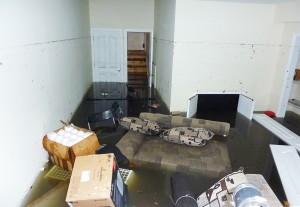The Damp Basement Dilemma
 With leaky or flooded basements, the problem is easy to spot; liquid water is getting into your basement, usually through a crack in the walls and/or foundation of the building. But when a basement is damp, and there doesn’t appear to be any likely place for water to get in, how and why does this happen? And more importantly, is there anything you can do about it?
With leaky or flooded basements, the problem is easy to spot; liquid water is getting into your basement, usually through a crack in the walls and/or foundation of the building. But when a basement is damp, and there doesn’t appear to be any likely place for water to get in, how and why does this happen? And more importantly, is there anything you can do about it?
Vapor Invasion
The critical difference between a leaky or flooded basement and a damp basement rests in the amounts of water involved. With a damp basement, there aren’t necessarily any large, visible pools of water on the floor. Instead, you may simply encounter wet floors or wet walls, glistening with moisture, but otherwise not revealing any large, obvious amounts of water. Often in cases like this, it’s because water is not actually leaking through into the basement, at least, not water in its liquid form. Instead, what is happening is that water vapor or very small amounts of liquid are being drawn in through the concrete—which is naturally porous and may easily admit water to begin with—and it is reforming from vapor into small amounts of liquid in your basement. Another culprit for damp basements is the climate. Hot, humid summers such as those experienced in the Maryland area can put a lot of moisture in the air. Unfortunately, the cooler temperatures of most basements can then take that humid air and cause it to condense on the walls and floors, once again creating a damp basement environment.
As an isolated incident, this is nothing to worry about, but repeated exposure to a damp environment can affect electrical systems, such as heating and air conditioning units, and in older homes, this continued dampness can affect any wooden construction within the home, accelerating the erosion process. A consistently damp basement can also provide an ideal environment for mold or mildew colonies to grow, which can pose a health hazard if left unchecked.
The Solution
Depending on the situation, for some, simply purchasing a dehumidifier unit may be enough to offset damp basement problems. For others however, depending on how vulnerable the structure is, a final solution may be more extensive. It might require the installation of a waterproof membrane to prevent moisture from migrating through. Ultimately, the best way to find out what solution works for your particular situation is to consult with the experts. If you’d like to know more about damp basements, just get in touch with us here at AAAction Waterproofing for a consultation.
